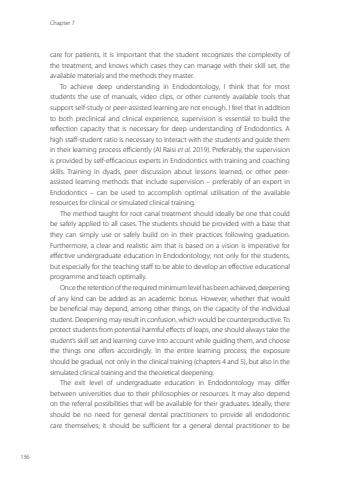Page 138 - Demo
P. 138
Chapter 7136care for patients, it is important that the student recognizes the complexity of the treatment, and knows which cases they can manage with their skill set, the available materials and the methods they master. To achieve deep understanding in Endodontology, I think that for most students the use of manuals, video clips, or other currently available tools that support self-study or peer-assisted learning are not enough. I feel that in addition to both preclinical and clinical experience, supervision is essential to build the reflection capacity that is necessary for deep understanding of Endodontics. A high staff-student ratio is necessary to interact with the students and guide them in their learning process efficiently (Al Raisi et al. 2019). Preferably, the supervision is provided by self-efficacious experts in Endodontics with training and coaching skills. Training in dyads, peer discussion about lessons learned, or other peerassisted learning methods that include supervision – preferably of an expert in Endodontics – can be used to accomplish optimal utilisation of the available resources for clinical or simulated clinical training.The method taught for root canal treatment should ideally be one that could be safely applied to all cases. The students should be provided with a base that they can simply use or safely build on in their practices following graduation. Furthermore, a clear and realistic aim that is based on a vision is imperative for effective undergraduate education in Endodontology; not only for the students, but especially for the teaching staff to be able to develop an effective educational programme and teach optimally. Once the retention of the required minimum level has been achieved, deepening of any kind can be added as an academic bonus. However, whether that would be beneficial may depend, among other things, on the capacity of the individual student. Deepening may result in confusion, which would be counterproductive. To protect students from potential harmful effects of leaps, one should always take the student’s skill set and learning curve into account while guiding them, and choose the things one offers accordingly. In the entire learning process, the exposure should be gradual, not only in the clinical training (chapters 4 and 5), but also in the simulated clinical training and the theoretical deepening. The exit level of undergraduate education in Endodontology may differ between universities due to their philosophies or resources. It may also depend on the referral possibilities that will be available for their graduates. Ideally, there should be no need for general dental practitioners to provide all endodontic care themselves; it should be sufficient for a general dental practitioner to be Annemarie Baaij.indd 136 28-06-2023 12:26


